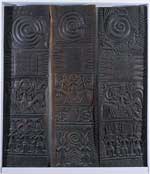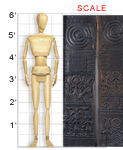VAM galleries including this work:
The Speed Art Museum | Do You See a Pattern? || VAM Home
Yoruba people (African, Nigeria)
YORUBA DOORS, late 19th century
Rosewood; each panel approx. 70" X 20"
Gift of Mrs. William Belknap, 76.12.1-.3
The Speed Art Museum
These panels, carved in the 1890s, probably served as doors in the home of a Yoruba military leader in the city of Ijebu-Ode in Nigeria. It is not known exactly how these panels functioned as doors, but they fit into a rich tradition of elaborate relief carvings used in the homes of Yoruba leaders and kings.
At the time these doors were made, different Yoruba groups were warring among themselves for control of European trade routes through Yorubaland. The British army interceded in 1892 in an effort to maintain control. The doors may tell the story of that conflict and emphasize the importance of two Yoruba gods in their culture. These panels not only served as functional doors in a Yoruba home, but also would have served as a historical record and even, perhaps, a cautionary tale for the people who saw them every day. The Yoruba would have easily read the meaning of the patterns, symbols, and costumes carved on the doors.
In addition to this symbolic role, the designs and patterns add decorative details that enrich the surface of what would have been a set of functional doors. If you look at the edges of the picture panels and even within the panels themselves, you will see that the surface of the wood has been brought to life with richly patterned textures. The artist has used many different forms and patterns, putting them together in various combinations that flow and pulse with energetic rhythms.
About the Artist
The name of the person who carved these doors is not known. However, research indicates that the sculptor was probably well known in his own community.
The Yoruba people comprise about 25 different lineage-based groups who share the Yoruba language in common. Their earliest cities at Oyo and Ife date back to 800-1000 CE. The Yoruba are farmers, tradesmen, and craftsmen known for their fine work in wood, metal, pottery, and weaving. Today they number about 20 million people worldwide, though most Yoruba still live in or near Nigeria.
People living in lineage-based groups all trace their ancestry to a single person. Lineage-based groups are inherently stable and exclusive, since their shared heritage permanently links and defines them. The beliefs, myths, and rituals of lineage-based groups typically revolve around ancestor-gods and their role in the present. Lineage-based groups have developed in cultures around the globe, from the royalty of Great Britain to some of the native peoples of North America.
Classroom Ideas
Discussion: Examine the photo of the doors and this drawing of the panel details. Find and list examples of pattern in the doors. Some scholars believe that the abstract interwoven patterns might actually refer to universal energies or power. Discuss why this idea could be true or false.
How do you and your family decorate your refrigerator door at home? Does it display pictures, magnets, stickers, etc.? What do the things that decorate your doors say about your family and what is important to it? How do you decorate your room or locker? Do you try to decorate with a particular style, or do your decorations evolve? Reflect on and discuss the choices you make in decorating your own spaces.
Activities:
- The Yoruba doors use several examples of animals within their overall design. The coiled snakes are meant to embody the restrained and potent power of a snake just before it strikes. The lizard is thought by some to be like a chameleon, a lizard that is able to change its colors and markings to stay camouflaged. The horses depicted in the doors were considered to be status symbols as well as a means of transportation.
In our own culture, we often use animals as symbols of attributes or characteristics that have particular meaning for us. For instance, your school may have an animal for a mascot—an animal that has qualities that are meant to inspire students to achieve their goals. Choose an animal whose attributes you admire for your own symbol. Draw or find an image of the animal and then write a short essay on its powerful and positive attributes. - Discuss the idea of family, from a nuclear family to an extended family.
(The extended family can accommodate friends, step-siblings, great-grandparents,
cousins, and others.) Write a short story about a family. The story can focus
on a particular event such as a holiday or birthday celebration, or it may
simply be a “slice-of-life” everyday occurrence. Illustrate your
story.
- As a class, tell a story about an event you have all experienced, such as a field trip or school activity. Cover your classroom door with a sheet of bulletin board paper and create a door design using symbols and figures to tell the story. Let the designs and motifs of the Yoruba doors guide some of the design choices in this artistic process.
Links
Read more about the Yoruba doors at the Speed Art Museum web site.
[www.speedmuseum.org/yoruba.html]
The online exhibit Cutting to the Essence, Shaping for the Fire has essays and information on Yoruba and Akan art.
[www.fa.indiana.edu/~conner/africart/home.html]
Learn about the Yoruba people at the Art & Life in Africa web site.
[www.uiowa.edu/~africart/toc/people/Yoruba.html]

